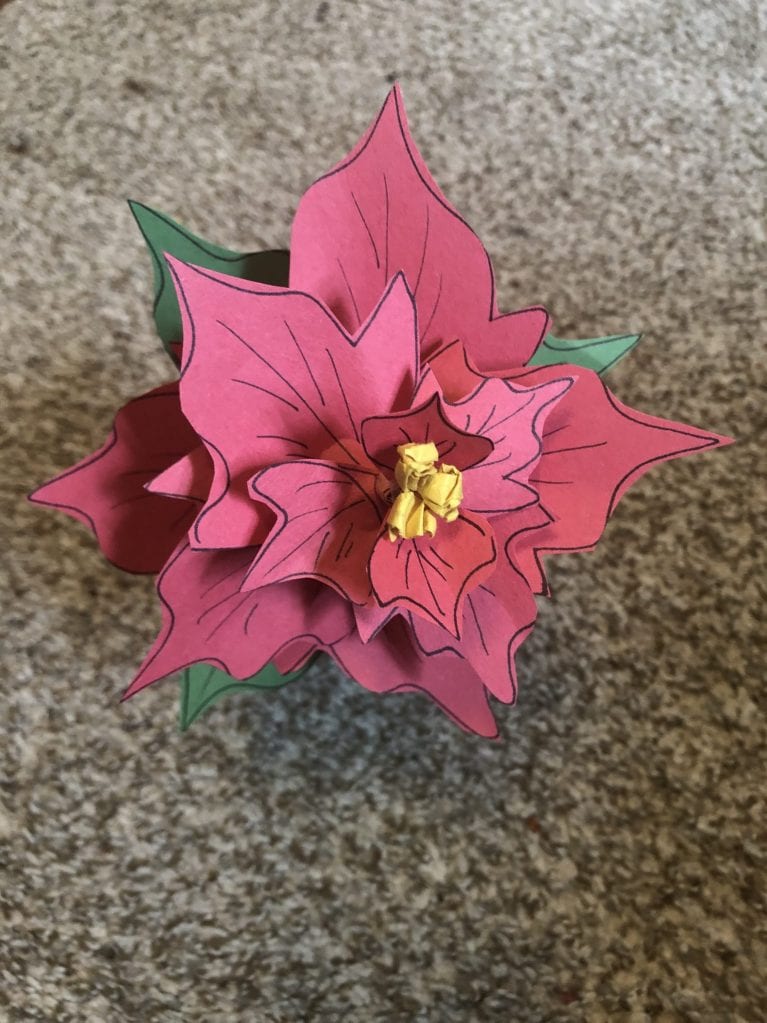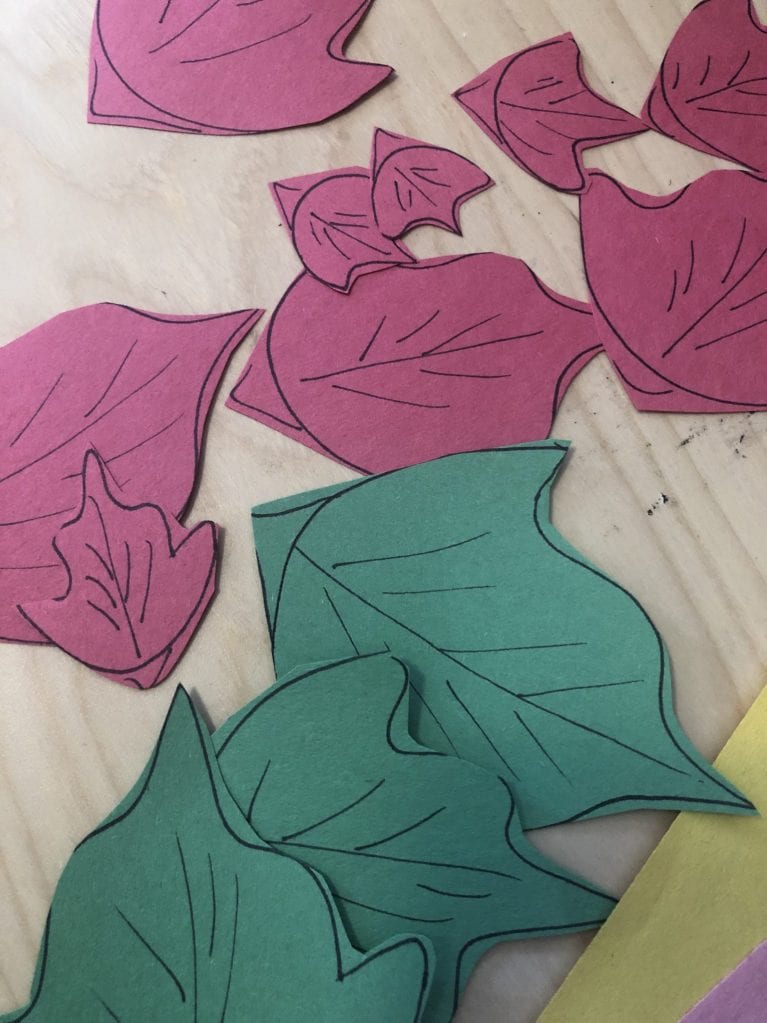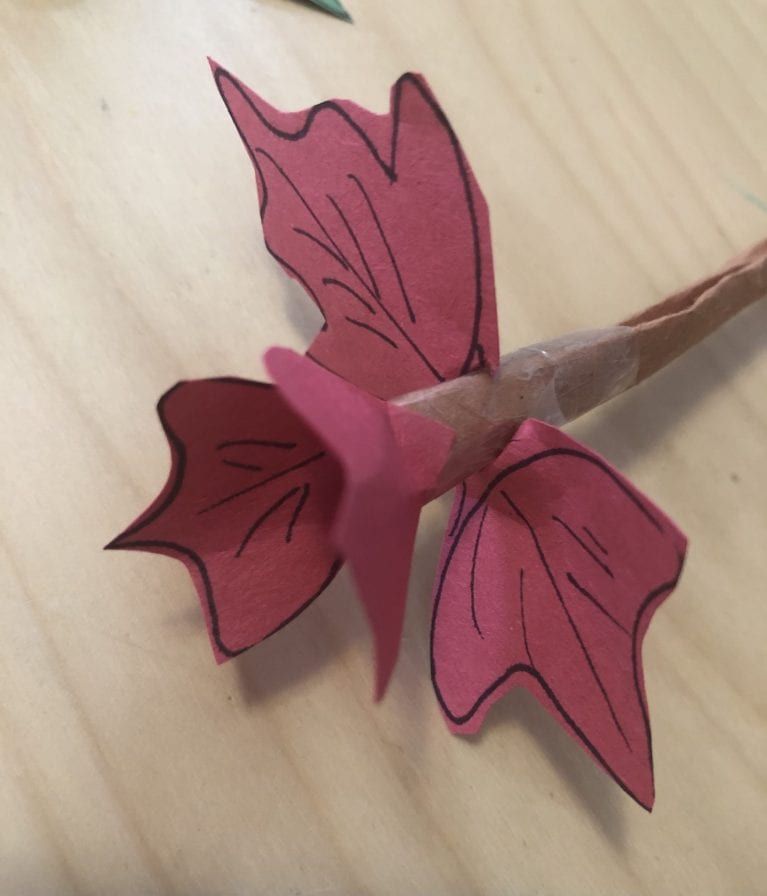Celebrate the holiday season by creating paper la cuetlaxochitl (Kwet -la-sho-cheel) and learn a decolonized history of this popular winter holiday flower.

The original name of poinsettia is cuetlaxochitl in the Aztec language, Nahuatl. La cuetlaxochitl is indigenous to what is now referred to as Mexico. The flower was an important part of Aztec culture and still holds significance to Indigenous Peoples today. Joel Poinsett stole the flower from Mexico and introduced it to the United States where the flower received its English name, poinsettia in reference to Poinsett.
Supplies
Color Paper, Scissors, Tape or Glue
Instructions
Step 1: La cuetlaxochitl comes in a variety of colors including red, white, pink or a mixture of colors. Decide which color or colors of the flower you want to make.
Step 2: Use a pencil to draw the flower’s leaves on green paper and additional leaves on the color paper of your choice.
Step 3: Use scissors to cut out the leaves.
Step 4: Roll up a piece of paper to create the stem of the flower.
Step 5: Use tape or glue to attach the leaves to the stem.
Step 6: Create the flowers or yellow center of the plant by ripping yellow paper into strips then use your index finger and thumb to roll a strip into a ball. Use tape or glue to attach the flowers in the center of your plant.
Step 7: Practice pronouncing the true name of the winter flower, la cuetlaxochitl (Kwet-la-sho-cheel). Show your friends and family your artwork and share what you learned about this flower’s history. Encourage them to use its true name.
Vocabulary
Indigenous – an adjective use to describe a person, plant, or animal that is native to from a specific area
Colonization – occurs when one country or group of people take control of another country or region and establish a settlement or colony. One of the reasons countries formed colonies was to take advantage of natural resources in new lands. They took precious metals, gems, timber, and furs from the territories and sold them to make money for themselves.



CHECK OUT OGDENMUSEUMONLINE FOR MORE RESOURCES!
QUESTIONS? EMAIL EDUCATION@OGDENMUSEUM.ORG.
________________________________________________________________________
Actividad artística O-riginal: Escultura de flor de papel La Cuetlaxóchitl (Poinsettia)
Celebra la temporada navideña creando una cuetlaxóchitl (Kwet -la-sho-cheel) de papel y aprende una historia descolonizada de esta popular flor navideña de invierno.

El nombre original de la poinsettia es cuetlaxóchitl en el idioma azteca, náhuatl. La cuetlaxóchitl es nativa de lo que ahora se conoce como México. La flor fue una parte importante de la cultura azteca y todavía tiene importancia para los pueblos indígenas de hoy. Joel Poinsett robó la flor de México y la introdujo en los Estados Unidos donde la flor recibió su nombre en inglés, poinsettia en referencia a Poinsett.
Materiales
Papel de color, tijeras, cinta adhesiva o pegamento
Instrucciones
Paso 1: La cuetlaxóchitl viene en una variedad de colores que incluyen rojo, blanco, rosa o una mezcla de colores. Decide qué color o colores de flor quieres hacer.
Paso 2: Utiliza un lápiz para dibujar las hojas de la flor en papel verde y hojas adicionales en el papel de color que elijas.
Paso 3: Utiliza las tijeras para recortar las hojas.
Paso 4: Enrolla una hoja de papel para crear el tallo de la flor.
Paso 5: Utiliza cinta adhesiva o pegamento para adherir las hojas al tallo.
Paso 6: Crea las flores o el centro amarillo de la planta cortando papel amarillo en tiras y luego usa tu dedo índice y pulgar para enrollar una tira y formar una bola. Utiliza cinta o pegamento para pegar las flores en el centro de tu planta.
Paso 7: Practica pronunciar el verdadero nombre de la flor de invierno, la cuetlaxóchitl (Kwet-la-sho-cheel). Muéstrale a tus amigos y familiares tu obra de arte y comparte lo que aprendiste sobre la historia de esta flor. Anímalos a usar su verdadero nombre.
Vocabulario
Nativa: adjetivo que se usa para describir a una persona, planta o animal que es nativo de un área específica.
Colonización: ocurre cuando un país o grupo de personas toma el control de otro país o región y establece un asentamiento o colonia. Una de las razones por las que los países formaron colonias fue para aprovechar los recursos naturales en nuevas tierras. Tomaron metales preciosos, gemas, madera y pieles de los territorios y los vendieron para ganar dinero para sí mismos.



¡VISITA OGDEN MUSEUM ONLINE PARA MÁS RECURSOS
¿PREGUNTAS? ENVÍA UN EMAIL A EDUCATION@OGDENMUSEUM.ORG
Translation by Agostina Coll
